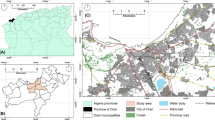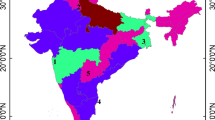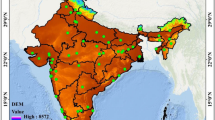Abstract
India and Pune city are experiencing infrastructural changes like never before on a more extensive and smaller scale, respectively. However, the infrastructure changes also degrade air quality due to various air pollutants. Additionally, the concentration of air pollutants affects the health of the atmosphere. Traditional ground station-based systems are tedious and challenging to monitor the necessary daily concentrations. Therefore, it is essential to monitor air quality through the latest technologies. In this case, satellite datasets could be the best choice to monitor air pollutants. Thus, the present study finds out the changes in the concentration of air pollutants Carbon Monoxide (CO), Formaldehyde (HCHO), Nitrogen Dioxide (NO2), Ozone (O3), Sodium Dioxide (SO2), Methane (CH4), and Particulate Matter (PM2.5) in the period of 2020 to 2023 using satellite and ground station dataset. The experiments were conducted using Google Earth Engine (GEE) and QGIS 3.34. The concentration of air pollutants swayed from 2020 to 2023, with an increase in 2021. The outcome of the present study could be used in urban planning and management.












Similar content being viewed by others
Data Availability
The data will be made available upon reasonable request.
References
Ahn DH, Choi T, Kim J, Park SS, Lee YG, Kim SJ, Koo JH. Southern Hemisphere mid-and high-latitudinal AOD, CO, NO 2, and HCHO: spatiotemporal patterns revealed by satellite observations. Prog Earth Planet Sci. 2019;6:1–16.
Aghdam FZ, Hasanlou M, Dehghanijabbarlou M. Quantifying urban air quality through multispectral satellite imagery and Google earth Engine. J Atmos Solar Terr Phys. 2024;261: 106301.
Alvim DS, Chiquetto JB, D’Amelio MTS, Khalid B, Herdies DL, Pendharkar J, Nobre P. Evaluating carbon monoxide and aerosol optical depth simulations from CAM-Chem using satellite observations. Remote Sens. 2021;13(11):2231.
Amani M, Ghorbanian A, Ahmadi SA, Kakooei M, Moghimi A, Mirmazloumi SM, Brisco B. Google earth engine cloud computing platform for remote sensing big data applications: a comprehensive review. IEEE J Sel Top Appl Earth Observ Remote Sens. 2020;13:5326–50.
Anand V, Panicker AS, Beig G. Gaseous pollutants over different sites in a metropolitan region (Pune) over India. SN Appl Sci. 2020;2:1–19.
Behera MD, Mudi S, Shome P, Das PK, Kumar S, Joshi A, Sirivella Z. COVID-19 slowdown induced improvement in air quality in India: rapid assessment using Sentinel-5P TROPOMI data. Geocarto Int. 2022;37(25):8127–47.
Bugdayci I, Ugurlu O, Kunt F. Spatial analysis of SO2, PM10, CO, NO2, and O3 pollutants: the case of Konya Province. Turkey Atmosphere. 2023;14(3):462.
Butz A, Galli A, Hasekamp O, Landgraf J, Tol P, Aben I. TROPOMI aboard Sentinel-5 Precursor: prospective performance of CH4 retrievals for aerosol and cirrus loaded atmospheres. Remote Sens Environ. 2012;120:267–76.
Central Pollution Control Board (CPCB) https://airquality.cpcb.gov.in/ccr/#/caaqm-dashboard-all/caaqm-landing. Accessed 02 Jul 2024.
Chandra A, Singh S. An assessment of air quality indicators Sentinel-5P TROPOMI data were used to examine the NO2 SO2 O3 AEROSOL levels in Uttar Pradesh before, after, and during the COVID 19 phase. World J Adv Res Rev. 2023;20(1):324–36.
Domingo JL, Rovira J. Effects of air pollutants on the transmission and severity of respiratory viral infections. Environ Res. 2020;187: 109650.
Gautam S. COVID-19: air pollution remains low as people stay at home. Air Qual Atmos Health. 2020;13(7):853–7.
Glencross DA, Ho TR, Camina N, Hawrylowicz CM, Pfeffer PE. Air pollution and its effects on the immune system. Free Radical Biol Med. 2020;151:56–68.
Gurjar BR, Ravindra K, Nagpure AS. Air pollution trends over Indian megacities and their local-to-global implications. Atmos Environ. 2016;142:475–95.
Haque MN, Sharif MS, Rudra RR, Mahi MM, Uddin MJ, Abd Ellah RG. Analyzing the spatio-temporal directions of air pollutants for the initial wave of COVID-19 epidemic over Bangladesh: application of satellite imageries and Google Earth Engine. Remote Sens Appl Soc Environ. 2022;28: 100862.
Ialongo I, Virta H, Eskes H, Hovila J, Douros J. Comparison of TROPOMI/Sentinel-5 Precursor NO 2 observations with ground-based measurements in Helsinki. Atmospheric measurement techniques. 2020;13(1):205–18.
Jodhani KH, Gupta N, Parmar AD, Bhavsar JD, Patel D, Singh SK, Omar GJ. Unveiling seasonal fluctuations in air quality using Google Earth Engine: a case study for Gujarat, India. Top Catal. 2024;67:961–982. https://doi.org/10.1007/s11244-024-01957-1
Kantakumar LN, Kumar S, Schneider K. What drives urban growth in Pune? A logistic regression and relative importance analysis perspective. Sustain Cities Soc. 2020;60: 102269.
Karim I, Rappenglück B. Impact of Covid-19 lockdown regulations on PM2 5 and trace gases (NO2, SO2, CH4, HCHO, C2H2O2 and O3) over Lahore. Pakistan Atmos Environ. 2023;303:119746.
Kazemi Garajeh M, Laneve G, Rezaei H, Sadeghnejad M, Mohamadzadeh N, Salmani B. Monitoring trends of CO, NO2, SO2, and O3 pollutants using time-series sentinel-5 images based on google earth engine. Pollutants. 2023;3(2):255–79.
Madkour KM. Monitoring the impacts of COVID-19 pandemic on climate change and the environment on Egypt using Sentinel-5P Images, and the Carbon footprint methodology. Egyptian J Remote Sens Sp Sci. 2022;25(1):205–19.
Mamić L, Gašparović M, Kaplan G. Developing PM2.5 and PM10 prediction models on a national and regional scale using open-source remote sensing data. Environ Monit Assess. 2023;195(6):644.
Mampitiya L, Rathnayake N, Leon LP, Mandala V, Azamathulla HM, Shelton S, Rathnayake U. Machine learning techniques to predict the air quality using meteorological data in two urban areas in Sri Lanka. Environments. 2023;10(8):141.
Morillas C, Alvarez S, Pires JC, Garcia AJ, Martinez S. Impact of the implementation of Madrid’s low emission zone on NO2 concentration using Sentinel-5P/TROPOMI data. Atmos Environ. 2024;320: 120326.
Ojha A, Mukherjee S. Evaluation of cost benefit analysis of air pollution impact on health in Pune City.
Okoduwa KA, Amaechi CF. Monitoring and mapping of atmospheric concentration of carbon monoxide, sulphur dioxide, and nitrogen dioxide from 2019–2022 in Benin City, Southern Nigeria. J Appl Sci Environ Manag. 2023;27(12):2715–22.
Phuong DTK, Nhut MC, Tri ND. Air pollution assessment using RS and Gis in Ho Chi Minh City, Viet Nam: a case study of period 2015–2019 for SO2 and NO2. IOP Conf Ser Earth Environ Sci. 2021;652(1):012004.
Rabiei-Dastjerdi H, Mohammadi S, Saber M, Amini S, McArdle G. Spatiotemporal analysis of NO2 production using TROPOMI time-series images and Google Earth Engine in a middle eastern country. Remote Sensing. 2022;14(7):1725.
Sari NM, Kuncoro MNS. Monitoring of CO, NO2 And SO2 levels during the covid-19 pandemic In Iran using remote sensing imagery. Geography, Environment, Sustainability. 2021;14(4):183–91.
Scaria HP, Avanthika P, Jose AM, Alisa JS, Sadasivan A, Varghese GK. Relational Study of PM2. 5 Surface Concentration with MODIS Level 3 AOD Data Over India. In: International Conference on civil engineering trends and challenges for sustainability, 2021, pp. 99–113). Singapore: Springer Nature Singapore.
Sharma S, Zhang M, Gao J, Zhang H, Kota SH. Effect of restricted emissions during COVID-19 on air quality in India. Sci Total Environ. 2020;728: 138878.
Shaw N, Gorai AK. Study of aerosol optical depth using satellite data (MODIS Aqua) over Indian Territory and its relation to particulate matter concentration. Environ Dev Sustain. 2020;22:265–79.
Siddiqui A, Halder S, Kannemadugu HBS, Prakriti, Chauhan P. Detecting methane emissions from space over India: analysis using EMIT and Sentinel-5P TROPOMI datasets. J Indian Soc Remote Sens. 2024;52:1901–1921. https://doi.org/10.1007/s12524-024-01925-y
Tamiminia H, Salehi B, Mahdianpari M, Quackenbush L, Adeli S, Brisco B. Google Earth Engine for geo-big data applications: A meta-analysis and systematic review. ISPRS J Photogramm Remote Sens. 2020;164:152–70.
Uyar N. Monitoring and analysis of air quality in Zonguldak Province by remote sensing. Türkiye Uzaktan Algılama Dergisi. 2024;6(1):57–67.
Vîrghileanu M, Săvulescu I, Mihai BA, Nistor C, Dobre R. Nitrogen Dioxide (NO2) Pollution monitoring with Sentinel-5P satellite imagery over Europe during the coronavirus pandemic outbreak. Remote Sens. 2020;12(21):3575.
Funding
Not Applicable.
Author information
Authors and Affiliations
Contributions
Suraj Shah: Concept, methodology, data analytics, original paper draft. Sandeep V. Gaikwad: Supervision, validation, writing & editing. Amol D. Vibhute: Investigation, supervision, validation, writing—review and final editing.
Corresponding author
Ethics declarations
Conflict of Interest
All the authors declare that he/she has no conflict of interest.
Research Involving Human and /or Animals
This research did not involve any human participants or animals.
Informed Consent
Not applicable.
Additional information
Publisher's Note
Springer Nature remains neutral with regard to jurisdictional claims in published maps and institutional affiliations.
Rights and permissions
Springer Nature or its licensor (e.g. a society or other partner) holds exclusive rights to this article under a publishing agreement with the author(s) or other rightsholder(s); author self-archiving of the accepted manuscript version of this article is solely governed by the terms of such publishing agreement and applicable law.
About this article
Cite this article
Shah, S.V., Gaikwad, S.V. & Vibhute, A.D. Air Quality Monitoring Using Sentinel-5p TROPOMI—A Case Study of Pune City. SN COMPUT. SCI. 5, 1125 (2024). https://doi.org/10.1007/s42979-024-03500-1
Received:
Accepted:
Published:
DOI: https://doi.org/10.1007/s42979-024-03500-1




